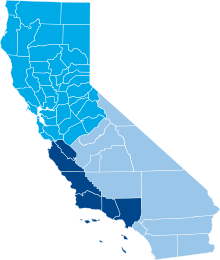Division of California into Three States | |
 Map of the three Californias Northern California (NorCal) California (Cal) Southern California (SoCal) |
| Elections in California |
|---|
 |
Cal 3 was a proposal to split the U.S. state of California into three states. It was launched in August 2017 by Silicon Valley venture capitalist Tim Draper, who led the effort to have it originally qualify on the November 2018 state ballot as Proposition 9, officially the Division of California into Three States initiative.[1] Proponents of the proposal argued that dividing California into three states would provide fairer and more responsive governance for large regions outside of California’s major cities. In July 2018, the Supreme Court of California pulled it from the ballot for further state constitutional review.[2] Draper officially stopped pushing for the measure soon after.[3][4][5][6] On 12 September 2018, the court permanently removed the measure from all future ballots.[7]
The Cal 3 proposal would not have legally split the state immediately; the division would have occurred only if and when the U.S. Congress consented to admit the new states to the Union per Article IV, Section 3 of the U.S. Constitution. Rather, the measure would have established procedures within the state government for the proposed split.
There were key procedural differences between the Cal 3 initiative and Draper's previous Six Californias plan, which failed to get enough signatures to qualify for the 2014 ballot. Among the differences, Cal 3 was an initiative to change a California statute, which required fewer petition signatures to qualify for the ballot than a proposed state constitutional amendment like the Six Californias plan. Also, language in the Cal 3 initiative was written so that if it was approved by the voters, the legislative consent required by Section 3 of Article IV "is given by the people" instead of directly by the California State Legislature.
As with his previous Six Californias plan, Draper and other proponents of Cal 3 said that the state is too large and ungovernable, and splitting California would produce smaller and more efficient state governments. Similarly to the previous plan, opponents said that such a split would be an unnecessary use of money and resources.
- ^ Zenter, Emily (June 29, 2018). "Here Are The 12 Ballot Propositions On California's November 2018 Election". Capital Public Radio. Retrieved June 30, 2018.
- ^ Egelko, Bob (July 18, 2018). "Splitting up California: State Supreme Court takes initiative off ballot". San Francisco Chronicle. Retrieved July 19, 2018.
- ^ "3 Californias Plan Dead As Billionaire Backer Drops Quest". CBS Sacramento. August 9, 2018. Retrieved August 25, 2018.
- ^ Betz, Bradford (August 9, 2018). "'Cal 3' proposal to divide California being pulled, billionaire backer says". Fox News. Retrieved August 25, 2018.
- ^ "Venture capitalist Tim Draper who spearheaded 3 Californias initiative will not fight court ruling". KABC-TV. August 9, 2018. Retrieved August 25, 2018.
- ^ Egelko, Bob (August 9, 2018). "Billionaire gives up campaign to split California into three states". San Francisco Chronicle. Retrieved August 25, 2018.
- ^ "PLANNING AND CONSERVATION LEAGUE v. PADILLA (DRAPER) - Case Number S249859". California Supreme Court. July 9, 2018. Retrieved November 5, 2018.